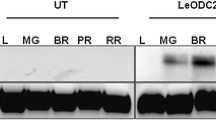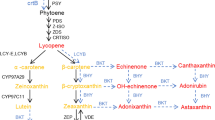Abstract
Polyamines (PAs) have been implicated in fruit ripening where they antagonize the action of ethylene: a ripening inducing phytohormone. S-adenosylmethionine decarboxylase (SAMDC) is a key enzyme involved biosynthesis of higher PAs- spermidine and spermine. Here, we report the genetic modification of tomato fruit ripening and quality by over-expressing human-SAMDC driven by fruit-specific promoter (2A11). The PA analysis of ripening fruits from these transgenics showed elevated PA levels in comparison to wild-type (WT). The increased levels of higher PAs are correlated with the accumulation of heterologous SAMDC transcripts in such fruits. Transgenic fruits exhibited reduced levels of ethylene (~50 %) production, ~10 days delay in on-vine ripening and extended post-harvest storage of ~11 days as compared to the WT fruits. As a result, these fruits showed improvement in various ripening traits like enhanced lycopene, vitamin C and total soluble solid. In Lesam fruits, an up-regulated expression of SlySAMDC, SlyEXP1, SlyTBG4, SlyDXS 1 and SlyPSY 1 was observed, while ethylene biosynthesis genes were down-regulated. Here, we have demonstrated the important role of PAs in altering the molecular and biochemical processes underlying fruit ripening by interfering with the ethylene biosynthesis.







Similar content being viewed by others
Abbreviations
- Put:
-
Putrescine
- SAMDC:
-
S-adenosylmethionine decarboxylase
- Spd:
-
Spermidine
- Spm:
-
Spermine
References
Adiga PR, Prasad GL (1985) Biosynthesis and regulation of polyamines in higher plants. Plant Growth Regul 3:205–226
AOAC (2000) Official methods of analysis. Association of Official Analytical Chemist. EUA
Asghar R, Majid R, Manoochehr M, Kholdebarin B, Saeid E et al (2010) The ameliorative effects of spermidine and calcium chloride on chilling injury in pomegranate fruits after long-term storage. Fruits 665:169–178
Bajaj S, Rajam MV (1996) Polyamine accumulation and near loss of morphogenesis in long term Callus cultures of rice: restoration of plant regeneration by manipulation of cellular polyamine levels. Plant Physiol 112:1343–1348
Bardocz S, Grant G, Brown DS, Pusztai A (1998) Putrescine as a source of instant energy in the small intestine of the rat. Gut 42:24–28
Berta G, Altamura M, Fusconi A, Cerruti F, Capitani F, Bagni N (1997) The plant cell wall is altered by inhibition of polyamine biosynthesis. New Phytol 137:569–1146
Costa G, Bagni N (1983) Effect of polyamines on fruit set of apple. HortSci 18:59–61
Doyle JJ, Doyle JL (1990) Isolation of plant DNA from fresh tissue. Focus 12:13–15
Evans PT, Malmberg RL (1989) Do polyamines have a role in plant development? Annu Rev Plant Physiol Plant Mol Biol 40:235–269
Guillén F, Castillo S, Zapata PJ, Martínez-Romero D, Serrano M, Valero D (2007) Efficacy of 1-MCP treatment in tomato fruit: 1. Duration and concentration of 1-MCP treatment to gain an effective delay of postharvest ripening. Postharvest Biol Technol 43:23–27
Hackett RM, Ho CW, Lin Z, Foote HC, Fray RG, Grierson D (2000) Antisense inhibition of the Nr gene restores normal ripening to the tomato Never-ripe mutant, consistent with the ethylene receptor-inhibition model. Plant Physiol 124:1079–1086
Handa AK, Mattoo AK (2010) Differential and functional interactions emphasize the multiple roles of polyamines in plants. Plant Physiol Biochem 48:540–546
Hobbs SLA, Kpodar P, DeLong CMO (1990) The effect of T-DNA copy number, position and methylation on reporter gene expression in tobacco transformants. Plant Mol Biol 15:851–864
Hortwitz W (1960) Official and tentative method of analysis, 9th edn. Association of Official Agriculture Chemists, Washington, pp 314–320
Kasukabe Y, He L, Watakabe Y, Otani M, Shimada T, Tachibana S (2006) Improvement of environmental stress tolerance of sweet potato by introduction of genes for spermidine synthase. Plant Biotechnol 23:75–158
Khan AS, Singh Z, Abbasi NA, Swinny EE (2008) Pre- or postharvest applications of putrescine and low temperature storage affect fruit ripening and quality of ‘Angelino’ plum. J Sci Food Agric 88:1686–1695
Kumar SV, Rajam MV (2004) Polyamine-ethylene nexus: a potential target for post-harvest biotechnology. Indian J Biotechnol 3:299–304
Kumria R, Rajam MV (2002) Alteration in polyamine titers during Agrobacterium-mediated transformation of indica rice with ornithine decarboxylase gene affects plant regeneration potential. Plant Sci 162:769–777
Kusano T, Berberich T, Tateda C, Takahashi Y (2008) Polyamines: essential factors for growth and survival. Planta 228:367–381
Kushad MM, Dumbroff EB (1991) Metabolic and physiological relationship between the polyamine and ethylene biosynthetic pathways. In: Slocum RD, Flores HE (eds) Biochemistry and physiology of polyamines in plants. CRC Press, Boca Raton, pp 77–92
Li N, Parsons B, Liu D, Mattoo AK (1992) Accumulation of wound-inducible ACC synthase transcript in tomato fruit is inhibited by salicylic acid and polyamines. Plant Mol Biol 18:477–487
Madhulatha P, Pandey R, Hazarika P, Rajam MV (2007) High transformation frequency in Agrobacterium mediated genetic transformation of tomato by using polyamines and maltose in shoot regeneration medium. Physiol Mol Biol Plants 13:191–198
Martýnez-Romero D, Serrano M, Carbonell A, Burgos L, Riquelme F, Valero D (2002) Effects of postharvest putrescine treatment on extending shelf life and reducing mechanical damage in apricot. J Food Sci 67:1706–1712
Matzke AJM, Neuhuber F, Park YD, Ambros PF, Matzke MA (1994) Homology-dependent gene silencing in transgenic plants: epistatic loci contain multiple copies of methylated transgenes. Mol Gen Genet 244:219–229
Mehta R, Cassol T, Li N, Ali N, Handa AK, Mattoo AK (2002) Engineered polyamine accumulation in tomato enhances phytonutrient content, juice quality, and vine life. Nat Biotechnol 20:613–618
Meli VS, Ghosh S, Prabha TN, Chakraborty N, Chakraborty S, Datta A (2010) Enhancement of fruit shelf life by suppressing N-glycan processing enzymes. Proc Natl Acad Sci U S A 107(6):2413–2418
Messiaen J, Cambier P, Van Cutsem P (1997) Polyamines and pectins I. Ion exchange and selectivity. Plant Physiol 113(2):387–395
Mitra SK, Sanyal D (1990) Effect of putrescine on fruit set and fruit quality of Litchi. Gartenbauwiss 55:83–84
Nambeesan S, Datsenka T, Ferruzzi MG, Malladi A, Mattoo AK, Handa AK (2010) Overexpression of yeast spermidine synthase impacts ripening, senescence and decay symptoms in tomato. Plant J 63:836–847
Neily MH, Matsukura C, Maucourt M, Bernillon S, Deborde C, Moing A et al (2011) Enhanced polyamine accumulation alters carotenoid metabolism at the transcriptional level in tomato fruit over-expressing spermidine synthase. J Plant Physiol 168:242–252
Oke M, Pinhero RG, Paliyath G (2003) The effects of genetic transformation of tomato with antisense phospholipase D cDNA on the quality characteristics of fruits and their processed products. Food Biotechnol 17:163–182
Parra-Lobato MC, Gomez-Jimenez MC (2011) Polyamine-induced modulation of genes involved in ethylene biosynthesis and signalling pathways and nitric oxide production during olive mature fruit abscission. J Exp Bot 62:4447–4465
Pear JR, Ridge N, Rasmussen R, Rose RE, Houck CM (1989) Isolation and characterization of a fruit-specific cDNA and the corresponding clone from tomato. Plant Mol Biol 13:639–651
Phan TD, Bo W, West G, Lycett GW, Tucker GA (2007) Silencing of the major salt-dependent isoform of pectinesterase in tomato alters fruit softening. Plant Physiol 144:1960–1967
Pinhero RG, Almquist KC, Novotna Z, Paliyath G (2003) Developmental regulation of phospholipase D in tomato fruits. Plant Physiol Biochem 41:223–240
Ronen G, Cohen M, Zamir D, Hirschberg J (1999) Regulation of carotenoid biosynthesis during tomato fruit development: expression of the gene for lycopene epsilon-cyclase is down-regulated during ripening and is elevated in the mutant Delta. Plant J 17:341–351
Rose JKC, Bennett AB (1999) Cooperative disassembly of the cellulose-xyloglucan network of plant cell walls: parallels between cell expansion and fruit ripening. Trends Plant Sci 4:176–183
Rose JKC, Lee HH, Bennett AB (1997) Expression of a divergent expansin gene is fruit-specific and ripening-regulated. Proc Natl Acad Sci U S A 94:5955–5960
Sambrook J, Fritsch EF, Maniatis T (1989) Molecular cloning: a laboratory manual, 2nd edn. Cold Spring Harbor Laboratory, New York
Schwartz CE, Wang X, Stevenson RE, Pegg AE (2011) Spermine synthase deficiency resulting in X-linked intellectual disability (Snyder-Robinson syndrome). Methods Mol Biol 720:437–445
Seiler N (2004) Catabolism of polyamines. Amino Acids 26:217–233
Sheehy RE, Kramer M, Hiatt WR (1988) Reduction of polygalacturonase activity in tomato fruit by antisense RNA. Proc Natl Acad Sci U S A 85:8805–8809
Singh S, Pal RK (2008) Response of climacteric-type guava (Psidium guajava L.) to postharvest treatment with 1-MCP. Postharvest Biol Technol 47:307–621
Smith DL, Abbott JA, Gross KC (2002) Down-regulation of tomato β-galactosidase 4 results in decreased fruit softening. Plant Physiol 129:1755–1762
Sousadias MG, Smith TK (1995) Toxicity and growth-promoting potential of spermine when fed to chicks. J Anim Sci 73:2375–2381
Theologis A (1992) One rotten apple spoils the whole bushel: the role of ethylene in fruit ripening. Cell 70:181–185
Tiburcio AF, Kaur-Sawhney R, Galston AW (1990) Polyamine metabolism. In: Miflin BJ, Lea PJ (ed) Intermedatory nitrogen metabolism.16, the biochemistry of plants. Academic Press, pp 283–325
Torrigiani P, Bressanin D, Beatriz Ruiz K, Tadiello A, Trainotti L et al (2012) Spermidine application to young developing peach fruits leads to a slowing down of ripening by impairing ripening-related ethylene and auxin metabolism and signaling. Plant Physiol 146:86–98
Valero D, Martínez-Romero D, Serrano M (2002) The role of polyamines in the improvement of the shelf life of fruit. Trends Food Sci Technol 13:228–232
Waie B, Rajam MV (2003) Effect of increased polyamine biosynthesis on stress response in transgenic tobacco by introduction of human S-adenosyl-methionine gene. Plant Sci 164:727–734
Watada AE, Aulenbach BB, Worthington JT (1976) Vitamins A and C in ripe tomatrres as aifected by’ stage of ripeness at harvest and by supplementary ethylene. J Food Sci 41:856–858
Winer L, Apelbaum A (1986) Involvement of polyamines in the development and ripening of avocado fruits. J Plant Physiol 126:223–456
Xiong AS, Yao QH, Peng RH, Li X, Han PL, Fan HQ (2005) Different effects on ACC oxidase gene silencing triggered by RNA interference in transgenic tomato. Plant Cell Rep 23:639–646
Yahia EM, Contreras-Padilla M, Gonzalez-Aguilar G (2001) Ascorbic acid content in relation to ascorbic acid oxidase and polyamine content in tomato and bell pepper fruits during development, maturation and senescence. Lebensm Wiss Technol 34:452–457
Ziosi V, Bregoli AM, Bonghi C, Fossati T, Biondi S et al (2006) Transcription of ethylene perception and biosynthesis genes is altered by putrescine, spermidine and aminoethoxyvinylglycine (AVG) during ripening in peach fruit (Prunus persica). New Phytol 172:229–238
Acknowledgments
This work was generously supported by grants from the Department of Biotechnology (Govt. of India), New Delhi (Grant Nos. BT/PR/2990/Agr/16/232/2002 and BT/PR8657/PBD/16/738/2007), University Grants Commission–Special Assistance Programme and Department of Science and Technology–FIST programme. Research fellowships to P. Madhulatha and Aarti Gupta by the Council of Scientific and Industrial Research are acknowledged.
Author information
Authors and Affiliations
Corresponding author
Additional information
P. Madhulatha and Aarti Gupta contributed equally
Electronic supplementary material
Below is the link to the electronic supplementary material.
Supplementary Fig. 1
Molecular characterization of tomato primary transformants. (a) PCR with primers specific to NPT II gene: L-1 kb ladder; PC-Plasmid DNA; NC-DNA from untransformed control; Lesam 1–70-DNA from different transgenic tomato lines, (b) PCR with SAMDC gene-specific primers: L-1 kb ladder; PC-Plasmid DNA, NC-DNA from untransformed control; Lesam 1–56-DNA from different tomato transgenic lines, (c) Southern blot analysis of Lesam transgenics for copy number using NPT II gene probe. NC-DNA from untransformed control; Lesam 1–56- DNA from different transgenic tomato lines digested with XbaI enzyme. (d) PCR analysis of Lesam T3 progenies. L-Ladder; PC-Plasmid DNA; NC-DNA from untransformed control; D.1) PCR of Lesam16 D.2) PCR of Lesam24 D.3) PCR of Lesam56. 1–12 DNA from Lesam T3 progenies. (JPEG 85 kb)
Table S1
List of primer sets used in the study (DOC 50 kb)
Rights and permissions
About this article
Cite this article
Madhulatha, P., Gupta, A., Gupta, S. et al. Fruit-specific over-expression of human S-adenosylmethionine decarboxylase gene results in polyamine accumulation and affects diverse aspects of tomato fruit development and quality. J. Plant Biochem. Biotechnol. 23, 151–160 (2014). https://doi.org/10.1007/s13562-013-0194-x
Received:
Accepted:
Published:
Issue Date:
DOI: https://doi.org/10.1007/s13562-013-0194-x




